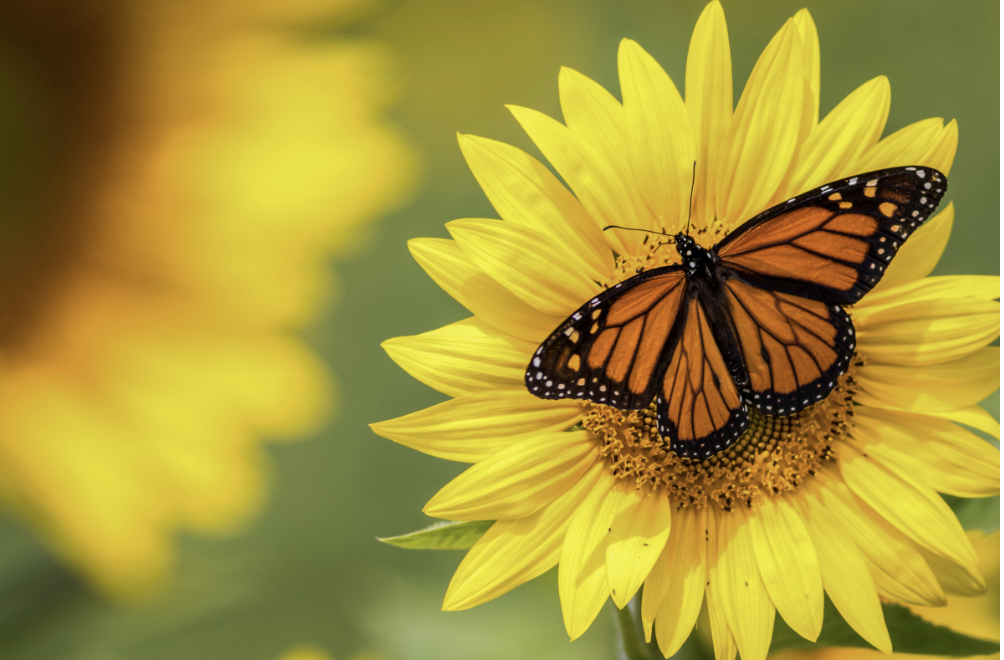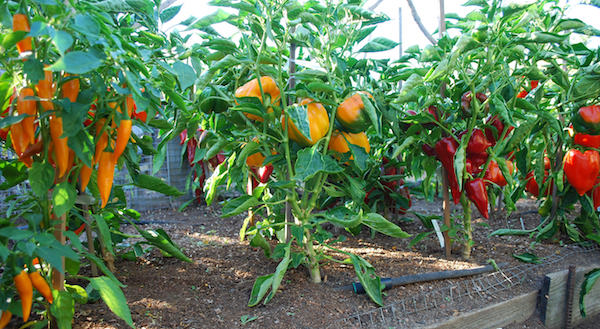All Seeds
Heirloom jubilee tomatoes (1943) are delicious, bright, and cheery. This lovely fruit is a wonderful addition to any salad or sandwich. Juicy and hearty, it can be used for any meal and features an attractive yellow color.
Growing Instructions:
Start Jubilee tomato seeds inside about 6-8 weeks before the last frost date. Transplant to a prepared garden bed or container after the danger of frost has passed. Tomatoes get bushy and need support from cages or a trellis.
Seed Information:
- Lifecycle: Annual (vegetable)
- Sowing Method: Transplant
- Time to Maturity/Harvest: 2.5 months
- Sun Requirement: Full sun
- Ideal Germination Temperature: 70-80°F
- Spacing: 18"
- Depth: 1/4"
- Height: 4'
- Seeds/Oz: 7,500
- Seeds Per Packet: 100-110 Jubilee tomato seeds
Uses:
Great for making sauces or tomato paste. High in fiber, vitamins C and K, potassium, folate, and lycopene, an antioxidant.
Additional Information:
- Heirloom Year: 1943
- Plant Scientific Name: Solanum lycopersicum
- Packet Size: 3 ¼" x 4 ½"
Online resale prohibited
This historic turnip variety is the most popular in the home garden. With its traditional flavor, the Purple Top Turnip is great for storage. Enjoy both the roots and the greens of this versatile vegetable.
Growing Instructions:
Plant seeds 1/4 inch deep in a prepared garden bed. Thin to 6" apart. Can be planted throughout the season but prefers cooler fall conditions.
Seed Information:
- Lifecycle: Annual (vegetable)
- Time to Maturity: About 2 months
- Sun Requirement: Sun
- Spacing: 6" apart
- Depth: 1/4 inch
- 835-845 seeds per packet
- Seeds/Oz: 9,500
- Ideal Germination Temperature: 70°F
- Sowing Method: Direct
Uses:
Purple Top Turnips are perfect for roasting, mashing, or using in soups and stews. The greens are also edible and nutritious.
Additional Information:
- Heirloom Year: 1881
- Plant Scientific Name: Brassica rapa subsp. rapa
- Packet Size: 3 ¼" x 4 ½"
Online resale prohibited
Turnip greens are nutritious and tasty, even better straight from your garden! This variety is grown for its wonderful greens.
Growing Instructions:
Starting in early spring, plant heirloom turnip seeds 1/4 inch deep in a prepared garden bed or container. Plant every 2 weeks for a continual harvest throughout the season. If you have a larger space, we also carry these top seven turnip seeds in bulk.
Seed Information:
- Lifecycle: Annual (vegetable)
- Time to Maturity: About 1 1/2 months
- Sun Requirement: Sun
- Spacing: 6" apart
- Depth: 1/4 inch
- 1100-1110 seeds per packet
- Seeds/Oz: 9,500
- Ideal Germination Temperature: 70°F
- Sowing Method: Direct
Uses:
Turnip greens are perfect for cooking in soups, stews, or simply sautéed for a healthy side dish.
Additional Information:
- Heirloom Year: Pre-1880
- Plant Scientific Name: Brassica rapa subsp. rapa
- Packet Size: 3 ¼" x 4 ½"
Online resale prohibited
This historic turnip variety is the most popular in the home garden. With its traditional flavor, the Heirloom Purple Top Turnip is great for storage. Enjoy both the roots and the greens of this versatile vegetable.
Growing Instructions:
Plant seeds 1/4 inch deep in a prepared garden bed. Thin to 6" apart. Can be planted throughout the season but prefers cooler fall conditions.
Seed Information:
- Lifecycle: Annual (vegetable)
- Time to Maturity: About 2 months
- Sun Requirement: Sun
- Spacing: 6" apart
- Depth: 1/4 inch
- 835-845 seeds per packet
- Seeds/Oz: 9,500
- Ideal Germination Temperature: 70°F
- Sowing Method: Direct
Uses:
Purple Top Turnips are perfect for roasting, mashing, or using in soups and stews. The greens are also edible and nutritious.
Additional Information:
- Heirloom Year: 1881
- Plant Scientific Name: Brassica rapa subsp. rapa
- Packet Size: 3 ¼" x 4 ½"
Online resale prohibited
Turnip greens are nutritious and tasty, even better straight from your garden! This Heirloom Seven Top variety is grown for its wonderful greens.
Growing Instructions:
Starting in early spring, plant heirloom turnip seeds 1/4 inch deep in a prepared garden bed or container. Plant every 2 weeks for a continual harvest throughout the season. If you have a larger space, we also carry these top seven turnip seeds in bulk.
Seed Information:
- Lifecycle: Annual (vegetable)
- Time to Maturity: About 1 1/2 months
- Sun Requirement: Sun
- Spacing: 6" apart
- Depth: 1/4 inch
- 1100-1110 seeds per packet
- Seeds/Oz: 9,500
- Ideal Germination Temperature: 70°F
- Sowing Method: Direct
Uses:
Turnip greens are perfect for cooking in soups, stews, or simply sautéed for a healthy side dish.
Additional Information:
- Heirloom Year: Pre-1880
- Plant Scientific Name: Brassica rapa subsp. rapa
- Packet Size: 3 ¼" x 4 ½"
Online resale prohibited
The classic watermelon, sporting a dark and light green striped skin with a red, flavorful flesh. The oval fruit typically measures about 10" to 12".
Growing Instructions:
Seeds can be started indoors about 4 weeks before the last frost. When spring weather has been consistently warm, transplant to rows or hills. Alternatively, plant seeds 36" apart outside, 2 weeks after the last frost in rows or hills. If possible, water during extended dry periods.
Seed Information:
- Lifecycle: Annual (vegetable)
- Time to Maturity: About 3 months
- Sun Requirement: Sun
- Spacing: 36" apart
- Depth: 1 inch
- 40-50 seeds per packet
- Seeds/Oz: 400
- Ideal Germination Temperature: 80°F
- Sowing Method: Transplant or Direct
Uses:
Watermelons are perfect for fresh eating, enjoying their sweet and refreshing flavor.
Additional Information:
- Heirloom Year: 1964
- Plant Scientific Name: Citrullus lanatus
- Packet Size: 3 ¼" x 4 ½"
Online resale prohibited
Oh baby! This sweet, round, smaller watermelon has been enjoyed by many for years. The dark-skinned fruit is about 6-8" in diameter.
Growing Instructions:
Bentley Seed Sugar Baby Watermelon seeds can be started indoors about 4 weeks before the last frost. When spring weather has been consistently warm, transplant to rows or hills. Alternatively, plant seeds 36" apart outside, 2 weeks after the last frost in rows or hills. If possible, water during extended dry periods.
Seed Information:
- Lifecycle: Annual (vegetable)
- Time to Maturity: About 2 1/2 months
- Sun Requirement: Sun
- Spacing: 36" apart
- Depth: 1 inch
- 25-35 seeds per packet
- Seeds/Oz: 400
- Ideal Germination Temperature: 75°F
- Sowing Method: Transplant or Direct
Uses:
Perfect for fresh eating, this smaller watermelon offers a sweet, refreshing taste.
Additional Information:
- Heirloom Year: 1959
- Plant Scientific Name: Citrullus lanatus
- Packet Size: 3 ¼" x 4 ½"
Online resale prohibited
A sun-loving, one-season annual wildflower seed mix. Supplement your perennial gardens for maximum color or plant it in its own space.
More than 20 annual wildflower varieties have been carefully blended into this quality, easy-to-grow mixture. These annual wildflower seed mix packets produce colorful plants throughout the growing season. Many varieties will re-seed themselves and produce for years. The large selection ensures that some varieties will survive wherever planted. Need wildflower seeds for shade instead? We have that, too!
Growing Instructions:
Plant in well-drained, cultivated soil during early spring or fall (recommended in mild climates). For best results, loosen soil with a rake or hoe. Mix seeds with a cup of sand or other inert material and spread over the calculated area. Lightly rake seed into the soil or cover with peat moss or similar light mulch. Keep soil moist until plants begin to grow.
Seed Information:
Lifecycle: Annual
Sun Requirement: Sun
Spacing: Varies
Bloom Season: Summer to fall
Height: Varies
Low Maintenance: Yes
Seeds Per Packet: 310-320
Sowing Method: Direct sow
Uses:
Single season
Cut flowers
Pollinator attractant
Wildflower garden
Additional Information:
Plant Scientific Name: Various
Packet Size: 3 ¼" x 4 ½"
Region: North America
Annual Wildflower Seed Mix Breakdown:
Baby Blue-Eyes, Forget-Me-Not Chinese, Candytuft Annual, Aster Single Mix, Cosmos Sensation Mix, Larkspur Rocket, California Poppy, Five-Spot, Corn Poppy, Dwarf Godetia, Bird's Eyes, Snapdragon, African Daisy, Creeping Daisy, Clarkia, Catchfly, Dwarf Plains Coreopsis, African Stick Daisy, Sweet Alyssum
Give back to nature with this gorgeous bee feed flower mix! It provides nectar and pollen to honey bees, wild bees, and other pollinators. It’s also ideal for borders and garden beds. Enjoy!
This bee feed mix is a blend of annual and perennial flowers that provide nectar and pollen to wild bees, honey bees, and other pollinators. It is well suited for maintained landscapes such as garden beds, borders, and managed meadows. It contains early, mid, and late blooming flowers to provide bee forage all season long. The flowers are suitable for both short-tongued and long-tongued bees and come in a wide range of colors for an attractive display. We also carry bulk wildflower seeds for bees!
Growing Instructions:
Prepare a bed of loose soil. Sprinkle bee feed seeds in the prepared area and cover loosely with soil. Keep the area moist until the plants are about 6" tall. It really is that easy!
Seed Information:
Lifecycle: Annual/Perennial mix
Time to Maturity: Varies
Sun Requirement: Sun
Spacing: 3"
Depth: 0.25"
Seeds Per Packet: 595-600
Bloom Season: Early summer to fall
Height: Varies
Low Maintenance: Yes
Region: North America
Uses:
Bee attractant
Ideal for borders and garden beds
Provides nectar and pollen for a variety of pollinators
Additional Information:
Bee Feed Flower Mix Breakdown:
Chinese Forget-Me-Not, Purple Coneflower, California Poppy, Blue Flax, Lance-Leaved Coreopsis, Annual Baby’s Breath, Corn Poppy, Crimson Clover, Siberian Wallflower, Clasping Coneflower, Indian Blanket, Baby Blue-Eyes, China Aster, Plains Coreopsis, Sweet Alyssum, Lavender Hyssop, Bergamot, Globe Gilia, New England Aster.
Plant Scientific Name: Various
Packet Size: 3 ¼" x 4 ½"
Online resale prohibited
This colorful, vibrant mix will attract all of your favorite winged friends! Blooms, nectar, and seeds - something for everyone!
This annual and perennial mixture is great for creating a backyard habitat to attract your favorite winged wildlife. Flowers in this mix will provide colorful blooms all season long, as well as nectar and seed for songbirds, hummingbirds, and butterflies.
Growing Instructions:
Prepare a bed of loose soil. Sprinkle seeds in the prepared area and cover loosely with soil. Keep the area moist until the plants are about 6" tall. It really is that easy!
Seed Information:
Lifecycle: Annual/Perennial Mix
Time to Maturity: Varies
Sun Requirement: Sun
Packet Weight: 600 mg
Bloom Season: Summer to Fall
595-600 Seeds Per Packet
Height: Varies
Low Maintenance: Yes
Oz Per 1000 Sq Ft: 8 Ounces
Uses:
Bird attractant, Bee attractant, Butterfly attractant, Pollinator
Additional Information:
Region: Midwest, Northeast, Northwest, Southeast, Southwest, Texas/Oklahoma, Canada, Western
Plant Scientific Name: Iberis amara, Erysimum, Consolida ajacis, Lupinus perennis, Liatris, Echinacea, Gaillardia, Eschscholzia californica, Callistephus chinensis, Centaurea cyanus, Gaillardia pulchella, Coreopsis lanceolata, Clarkia amoena, Ratibida, Coreopsis tinctoria, Monarda citriodora, Asclepias tuberosa, Lobularia maritima, Rudbeckia hirta
Packet Size: 3 ¼" x 4 ½"
Online Resale Prohibited
Brighten things up both inside and out with this lovely cut flower mix! Easy to plant, easy to grow, and even easier to enjoy!
Growing Instructions:
Prepare a bed of loose soil. Sprinkle seeds in the prepared area and cover loosely with soil. Keep the area moist until the plants are about 6" tall. It really is that easy!
Seed Information:
Lifecycle: Annual/Perennial Mix
Sun Requirement: Sun
240-245 Seeds Per Packet
Bloom Season: Summer to Fall
Height: Varies
Low Maintenance: Yes
Uses:
Cut Flowers
Additional Information:
Mix Breakdown:
Varieties Included: Tall Mixed Centaurea, Pacific Beauty Calendula, Annual Baby's Breath, Perennial Lupine, Dwarf Sunspot Sunflower, Sensation Mix Cosmos, California Giants Mix Zinnia, Sulphur Bright Lights Mix Cosmos, Blue Flax, Clarkia, Rocket Imperial Mix Larkspur, African Daisy, Mixed Annual Phlox, Tall Spurred Northern Lights Snapdragon, Plains Coreopsis, and Black-Eyed Susan.
Scientific Names:
Centaurea Cyanus, Calendula Officinalis, Gypsophila Elegans, Lupinus Perennis, Helianthus Annuus, Cosmos Bipinnatus, Zinnia Elegans, Cosmos Sulphureus, Linum Perenne, Clarkia Unguiculata, Delphinium Consolida, Dimorphotheca Sinuata, Phlox Drummondii, Linaria Maroccana, Coreopsis Tinctoria, Rudbeckia Hirta.
Packet Size: 3 ¼" x 4 ½"
Online resale prohibited
The Eastern Pollinator Mixture is designed for pollinator conservation in the eastern United States and southeast Canada. The western planting boundary extends south from the eastern borders of North and South Dakota. This mix contains a balanced blend of native annuals and perennials that provide nectar and pollen throughout the growing season. If you have specific mix requirements for pollinator conservation projects, please contact us regarding a custom mix for your area.
Growing Instructions:
Plant in well-drained cultivated soil during early spring or fall (recommended in mild climates). For best results, loosen soil with a rake or hoe. Mix seeds with a cup of sand or other inert material and spread over the calculated area. Lightly rake seed into soil or cover with peat moss or a similar light mulch. Keep soil moist until plants begin to grow.
Seed Information:
Lifecycle: Annual & Perennials
Bloom Season: Summer to Fall
Height: Varies
Seeds Per Packet: 172
Low Maintenance: Yes
Uses:
Pollinator conservation
Additional Information:
Region: North America
Plant Scientific Name: Rudbeckia hirta, Baptisia australis, Asclepias tuberosa, Oenothera biennis, Zizia aurea, Solidago grayi, Penstemon hirsutus, Gaillardia pulchella, Coreopsis lanceolata, Agastache foeniculum, Monarda citriodora, Aster novae-angliae, Tradescantia ohiensis, Chamaecrista fasciculata, Coreopsis tinctoria, Echinacea purpurea, Desmodium canadense, Pycnanthemum tenuifolium, Monarda punctata
Packet Size: 3 ¼" x 4 ½"
Online Resale Prohibited
Plant, water, and enjoy this native mix of perennials for years to come!
Growing Instructions:
Prepare a bed of loose soil. Sprinkle seeds in the prepared area and cover loosely with soil. Keep the area moist until the plants are about 6" tall. It really is that easy!
Seed Information:
Lifecycle: Perennial
Sun Requirement: Sun
Seeds Per Packet: 305-310
Bloom Season: Summer to Fall
Height: Varies
Low Maintenance: Yes
Uses:
Cut flowers
Beds
Wildflower gardens
Additional Information:
Mix Breakdown: Siberian Wallflower, Lance Leaved Coreopsis, Purple Coneflower, Blanketflower, Blue Flax, Perennial Lupine, Russel Lupine, Shasta Daisy, Sweet William, Gayfeather, Dwarf Columbine, Maltese Cross, Evening Primrose, Purple Moss Verbena, Black-Eyed Susan, Prairie Coneflower, Dwarf Red Coneflower, Greyheaded Coneflower.
Plant Scientific Name: Various
Packet Size: 3 ¼" x 4 ½"
Online resale prohibited
A delightfully easy sun-loving annual wildflower seed mix! Plant it and forget it – until it blooms!
Have a sunny open area ready to become a country wildflower field? We have you covered, quick and simple! Easy to establish, great to view or romp through, and perfect for any open area. Our sunny wildflower mix is a quality blend of bulk wildflower seeds, including black-eyed Susan and corn poppy, selected for open areas.
Growing Instructions:
Prepare a bed of loose soil. Sprinkle seeds in the prepared area and cover loosely with soil. Keep the area moist until the plants are about 6" tall. It really is that easy!
Seed Information:
Lifecycle: Annual
Sun Requirement: Sun
Seeds Per Packet: 230-235
Bloom Season: Summer to fall
Height: Varies
Low Maintenance: Yes
Region: Midwest, Northeast, Northwest, Southeast, Southwest, Texas/Oklahoma, Canada, Western
Uses:
Cut flowers
Great for children
Additional Information:
Lbs. Per Acre (First Seeding): 10 Pounds
Lbs. Per Acre (Reseeding): 5 Pounds
Oz Per 1000 Sq Ft: 4 Ounces
Mix Breakdown: Annual Baby's Breath, Crimson Clover, Cornflower, Arroyo Lupine, Calendula, Chinese Forget-Me-Not, Blue Flax, Garland Daisy, Siberian Wallflower, Tree Mallow, California Poppy, Scarlet Flax, Purple Coneflower, Plains Coreopsis.
Plant Scientific Name: Various
Packet Size: 3 ¼" x 4 ½"
Online resale prohibited
Texas Oklahoma Wildflower Mix is a curated regional mix for color throughout the season, ideal for gardens in Oklahoma and most of Texas. Enjoy continuous color from these flowers throughout the growing season. This curated mix contains native species as well as species that have adapted to the region. This annual and perennial wildflower seed bulk mixture is perfect for ornamental landscaping in OK and most of Texas. For the extreme southern tip of Texas, use the Gulf Coast/Caribbean Mix. For the far eastern edge of TX, use the Southeast Mix. Our bulk Texas/Oklahoma Wildflower Seed Mix will provide color throughout the growing season.
Growing Instructions:
Plant your Texas/Oklahoma wildflower seed mix in well-drained cultivated soil during early spring or fall (recommended in mild climates). For best results, loosen soil with a rake or hoe. Mix seeds with a cup of sand or other inert material and spread over the calculated area. Lightly rake seed into soil or cover with peat moss or similar light mulch. Keep soil moist until plants begin to grow.
Seed Information:
Lifecycle: Annual/Perennial Mix
Sun Requirement: Sun
Seeds Per Packet: 236
Bloom Season: Early Summer into Fall
Height: Varies
Low Maintenance: Yes
Uses:
Cut flowers, supports regional pollinators like bees, butterflies, and hummingbirds
Additional Information:
Region: Texas/Oklahoma
Sowing Method: Direct Sow
Plant Scientific Name: Gypsophila elegans, Iberis umbellata, Rudbeckia hirta, Rudbeckia amplexicaulis, Papaver rhoeas, Centaurea cyanus, Coreopsis nuecensis, Oenothera macrocarpa, Helenium amarum, Coreopsis basalis, Thelesperma filifolium, Gaillardia pulchella, Coreopsis lanceolata, Monarda citriodora, Ratibida columnifera, Echinacea purpurea, Dalea purpurea, Phlox drummondii, Salvia coccinea, Cosmos sulphureus, Lupinus texensis
Packet Size: 3 ¼" x 4 ½"
Online Resale Prohibited
This Western Pollinator Seed annual and perennial mixture is designed for ornamental landscaping in the western U.S. and Canada. It is suitable for elevations below 7,000 feet in areas such as CO, ID, western KS, MT, western NE, northern NV, ND, eastern OR, SD, UT, eastern WA, WY, southern Alberta, southeast British Columbia, and southern Saskatchewan. For elevations above 7,000 feet, we recommend the Mountain Mix. Flowers in this mixture will provide color throughout the growing season and include native species as well as non-native species that are adapted to the region.
Growing Instructions:
Plant in well-drained cultivated soil during early spring or fall (recommended in mild climates). For best results, loosen soil with a rake or hoe. Mix seeds with a cup of sand or other inert material and spread over the calculated area. Lightly rake seed into soil or cover with peat moss or similar light mulch. Keep soil moist until plants begin to grow.
Seed Information:
Lifecycle: Annual/Perennial Mix
Sun Requirement: Sun
Seeds Per Packet: 440
Bloom Season: Late Spring into Fall
Height: Varies
Low Maintenance: Yes
Uses:
Cut flowers, supports regional pollinators like bees, butterflies, and hummingbirds
Additional Information:
Region: Western
Sowing Method: Direct Sow
Plant Scientific Name: Varies
Packet Size: 3 ¼" x 4 ½"
Online Resale Prohibited
The classic Zinnia! Easy to grow with a wide range of beautiful colors and large flowers. These flowers come in colors including pink, purple, red, orange, white, and yellow, with large 4-5-inch-wide blooms that are semi-double to double. Excellent for attracting pollinators, especially butterflies. Great for cut flowers and container gardens.
Growing Instructions:
Prepare a bed of loose soil. Sprinkle seeds in the prepared area and cover loosely with soil. Keep the area moist until the plants are about 6” tall. Can be started indoors about 4 weeks before the last frost.
Seed Information:
Lifecycle: Annual
Sowing Method: Direct sow
Time to Maturity: 2.5-3 months
Bloom Season: Mid to late summer
Sun Requirement: Sun
Ideal Germination: 70-75°F
Spacing: 12"
Depth: 1/8"
Height: 36"
Seeds/Oz: 4000
Seeds Per Packet: 55-60
Low Maintenance: Yes
Uses:
Cut flowers
Great for children
Additional Information:
Plant Scientific Name: Zinnia elegans
Packet Size: 3 ¼" x 4 ½"
Online resale prohibited
Bring this bright, happy, easy-to-grow flower to your home! Blooms in a rainbow of colors including pink, purple, red, orange, white, and yellow. Considered semi-dwarf, the pompom-shaped double flowers are about 1.5 inches wide. Excellent for pollinators—especially butterflies. Easy to grow for cut flowers and container gardens.
Growing Instructions:
Press seeds 1/8 inch deep into loose soil. Water. Can be started indoors about 4 weeks before the last frost.
Seed Information:
Lifecycle: Annual
Sun Requirement: Sun
Spacing: 12" apart
Depth: 1/8"
115-120 Seeds Per Packet
Bloom Season: Mid to late summer
Height: 18" - 24"
Low Maintenance: Yes
Seeds/Oz: 6000
Sowing Method: Direct Sow
Uses:
Cut flowers
Containers
Great for children
Additional Information:
Plant Scientific Name: Zinnia elegans
Packet Size: 3 ¼" x 4 ½"
Online resale prohibited























































